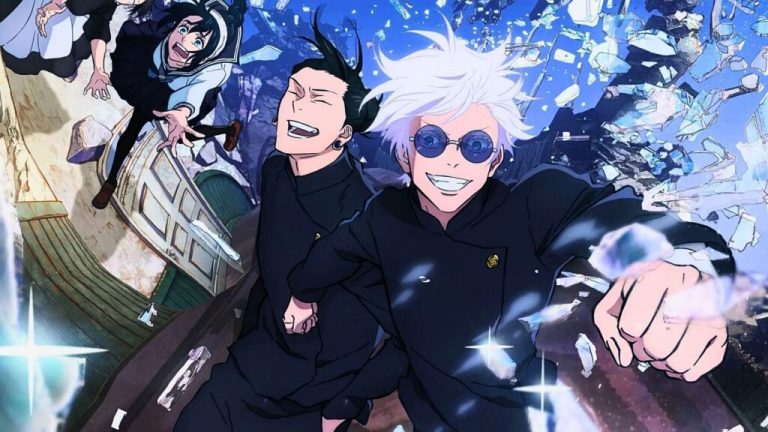Jujutsu Kaisen Season 2’s Prequel Arc Proves The Importance Of Breaking Form
Jujutsu Kaisen season 2’s unique approach to non-linear storytelling may throw off some viewers, but it’s the series’ strongest decision to date.

This article contains spoilers for Jujutsu Kaisen season 2 part 1.
Gege Akutami’s Jujutsu Kaisen has been a breakout hit ever since its debut in Weekly Shonen Jump back in 2018. In only five years, Jujutsu Kaisen’s manga has sold more than 80 million copies and is currently the 27th-best-selling manga of all-time.
Jujutsu Kaisen’s anime adaptation has proven to be just as popular, with its first season winning several awards, ranking at the top of many lists, and even becoming 2021’s second most discussed TV show on Twitter, anime or otherwise. Not to be outdone, the anime’s first feature film, Jujutsu Kaisen 0, is currently the ninth-highest-grossing Japanese movie ever made (beating the likes of Pokémon: The First Movie and Hayao Miyazaki’s Princess Mononoke). Clearly, excitement for Akutami’s dark signature shonen series isn’t going anywhere. This popularity buys the anime a lot of goodwill and trust with its audience, which is crucial when starting a second season.
Jujutsu Kaisen’s first season ended on a suspenseful, exciting note that anime fans have been waiting more than two years to get answers on. Jujutsu Kaisen’s second season finally made its triumphant debut in July 2023, but some audiences were confused when Yuji Itadori, Nobara Kugisaki, Maki Zen’in, and other fan favorite characters were nowhere to be seen. While initially jarring, Jujutsu Kaisen’s extended prequel arc that kicks off its second season is not only the smartest thing that the anime could have done, but a tactic that more shonen series could learn from. Here are some reasons why.
The Confidence Of Abandoning Core Cast
Yuji Itadori’s demonic possession and internal struggle is certainly reminiscent of similar shonen anime like Tokyo Ghoul, Blue Exorcist, Parasyte, and even shades of Yu Yu Hakusho and Bleach. These series all head down compelling paths in their second seasons, but they’re still largely conventional continuations of their original stories. These anime have rich worlds with decades of lore, just like Jujutsu Kaisen, but their compulsion to continue moving forward in a linear fashion ultimately does a disservice to their rich worlds. Jujutsu Kaisen strips its central players away during its second season’s “Hidden Inventory” prequel arc, which turns the clock back more than a decade to 2006 when acclaimed jujutsu sorcerer, Satoru Gojo, is just a cocky second-year student.
This pitstop in the past helps establish a stronger foundation that doesn’t need to consistently rely on the same handful of characters, but it also effectively highlights that Jujutsu Kaisen’s world is much bigger than simply Yuji and his fellow Tokyo Metropolitan Magic Technical College jujutsu sorcerer peers. They are important players, but not the most important. This humbling reality check helps Jujutsu Kaisen set up epic future conflicts, which may or may not involve season one’s crew. This prequel approach teaches the audience to stay alert and that this won’t just be a linear narrative. Some viewers were caught off guard when season two began, but Jujutsu Kaisen has now set a precedent for these types of detours. Each season could begin with a shorter story arc that’s set in the past–or even the future–as a creative way to set up the conflicts to come.
Jujutsu Kaisen previously found success with this angle in Jujutsu Kaisen 0, which is set a few years before the anime’s first season. Season two’s “Hidden Inventory” material builds upon this confidence and momentum by going even further with it. However, these radical deviations suddenly feel more natural since there has been increasing prequel content that’s kept fans satisfied before returning to Yuji’s story. All of this makes Yuji’s inevitable return hit even harder due to how it’s been that much longer since the core cast was seen and celebrated.
It Retroactively Strengthens Season 1
Jujutsu Kaisen’s first season is full of intimidating threats, but among the most vicious is powerful jujutsu sorcerer, Suguru Geto. There’s an intense relationship between Geto and Satoru Gojo, but much of it is left to the audience’s imagination, almost as if they’re in the same position as jujutsu newcomer, Yuji Itadori. Some of Jujutsu Kaisen 0’s most effective scenes are whenever Gojo and Geto are opposite each other, but they’re still treated like supporting players in someone else’s story. The whole point of “Hidden Inventory” is to get to the bottom of Gojo and Geto’s relationship. They’re introduced as trusted friends, only for the two of them to be pulled in the opposite extremes of jujutsu sorcery.
It’s previously been difficult to understand Geto’s motivations and his interest in Gojo. Season two’s prequel prelude explains Geto’s tragic fall from grace and his grander desire to wipe out all curses, which means the execution of all non-sorcerers. Gojo doesn’t just witness his best friend’s corruption, but he’s responsible for it in his own way by showing Geto just how far jujutsu sorcery can be taken. Gojo’s smug arrogance inspires this mass murderer to never give up. This is the perfect primer on Jujutsu Kaisen’s big villain before he re-emerges, stronger than ever. The audience has much greater understanding and empathy regarding Gojo and Geto’s relationship and the inevitable danger that it’s building towards in the season’s upcoming “Shibuya Incident” Arc.
Season two’s “Hidden Inventory” experience also provides greater context on the importance of Megumi Fushigoro, one of Yuji’s jujutsu peers and a fellow disciple of Gojo. Jujutsu Kaisen’s first season is largely viewed through Yuji’s perspective, but Megumi is there from the first episode and some fans have argued that he’s even more deserving of the protagonist role. “Hidden Inventory” further develops this theory through the tease that Megumi is the son of Toji, an infamous sorcerer killer. This arc ends with Gojo taking Megumi under his wing, an action that means much more in the greater context of his lineage. Gojo may view his time with Geto as a failure, but Megumi is a second chance to avoid the same mistakes. Megumi is destined to play a much bigger role in season two’s future and reiterates his importance over Yuji.
A Prequel Arc Works Better Than A Movie Or OVAs
Shonen anime are no strangers to prequels, but they routinely explore these stories through ancillary material. There’s nothing wrong with an anime that saves a prequel story for a feature film or a collection of OVAs that are released as addendums to a season. However, the issue with this approach is that there’s no guarantee that audiences will stray from the core series and actually watch them, even if they feature important parts of the canon. Yu Yu Hakusho’s prequel OVAs slipped through the cracks for many and Dragon Ball Super: Broly’s flashback prologue takes a bullet point approach to its plotting.
Jujutsu Kaisen’s decision to use this important prequel as the second season’s start immediately grabs the audience’s attention and speaks to its essential status. This structure also helps Jujutsu Kaisen develop its voice through deviating from other shonen norms. Season two feels fresh and distinctly different from its very first frame rather than just more of the same. There’s of course nothing wrong with “more of the same” when that’s in reference in Jujutsu Kaisen’s daring first season, but it’s a smart tactic to win over those who may not have been impressed, while stoking the flames of curiosity for those who were.
It Provides Symmetry and Structure To The Season
Jujutsu Kaisen‘s first season moves at an effective pace as it covers 24 episodes. Smaller story arcs are present in these two-dozen installments, but the season is primarily structured as one long narrative, which occasionally loses its way. Season two consists of 23 episodes, but they’re structured as two separate story arcs: “Hidden Inventory/Premature Death” and the “Shibuya Incident.” It’d be easy for Jujutsu Kaisen to evenly divide these two arcs across the season, but the prequel material only covers the first five entries, with the “Shibuya Incident” arc picking up in episode six for the next 18 installments.
This split structure greatly helps with the season’s pacing and momentum, but also shows that a season can be unevenly divided if that’s what’s best for the story. This opens up greater possibilities for a season three that could conclude with a shorter story arc, or even feature three or four arcs instead of one or two lengthier affairs. In a story that’s as grand as this, it only feels natural to be jumping through time to better appreciate the eternal nature of curses and how they’ve evolved since Gojo and Geto’s youth.
The fifth episode of Jujutsu Kaisen’s second season, “Premature Death,” coyly concludes with season one’s Tokyo crew waking Satoru Gojo up from what’s evidently been one long dream that’s sustained the season’s introductory arc. Now awake, in more ways than one, Gojo’s goal is recalibrated and he and his disciples can truly begin to wage war on Geto’s cabal of Cursed Spirits. It may have taken Jujutsu Kaisen a little longer than usual to return to its core cast, but it’s never been in a better position to take its story to new heights and continue to leave its comfort zone.
Jujutsu Kaisen season 2 returns on Aug. 31, 2023 for the start of the “Shibuya Incident” Arc. The first two seasons of Jujutsu Kaisen are available to stream on Crunchyroll.
